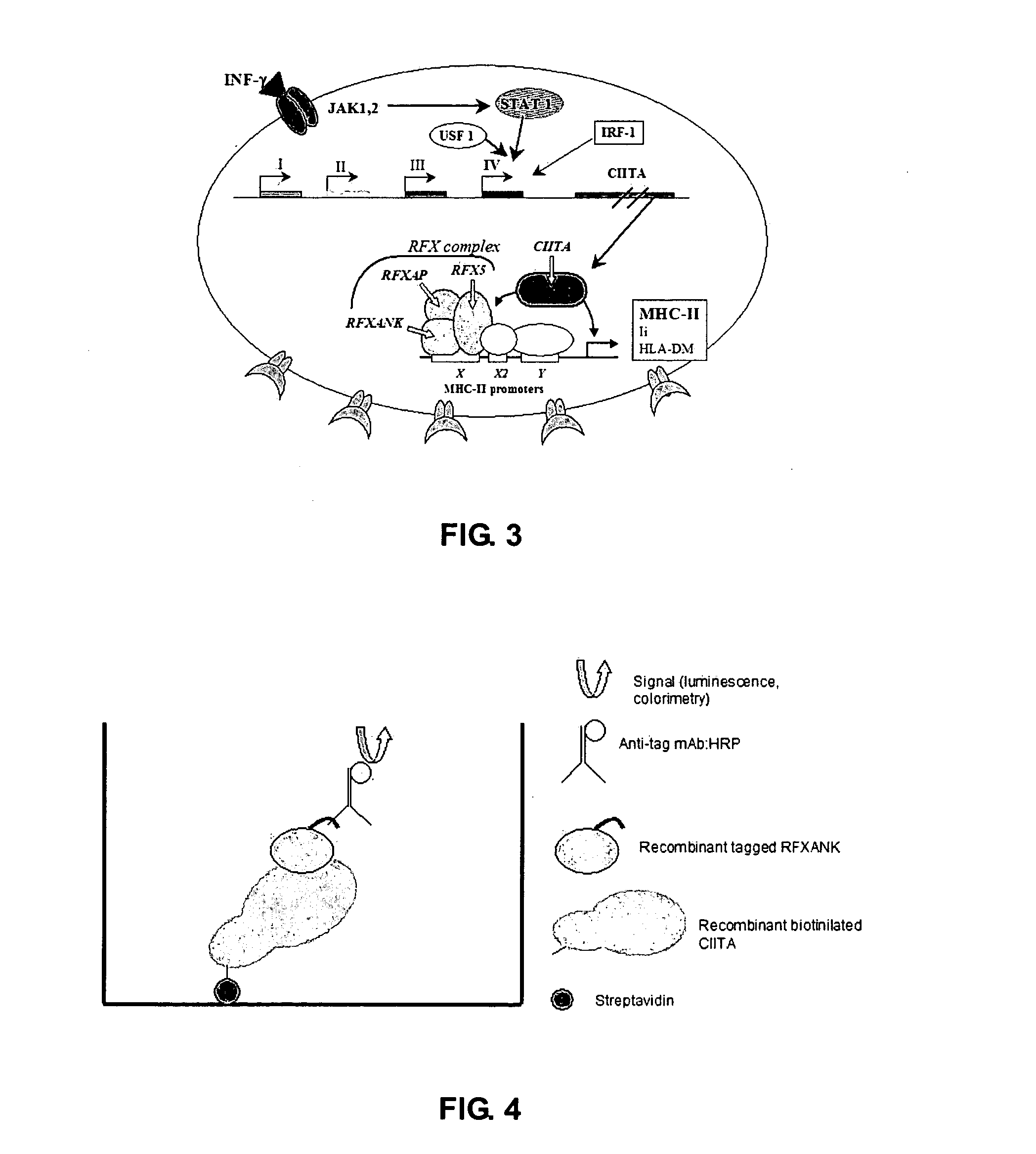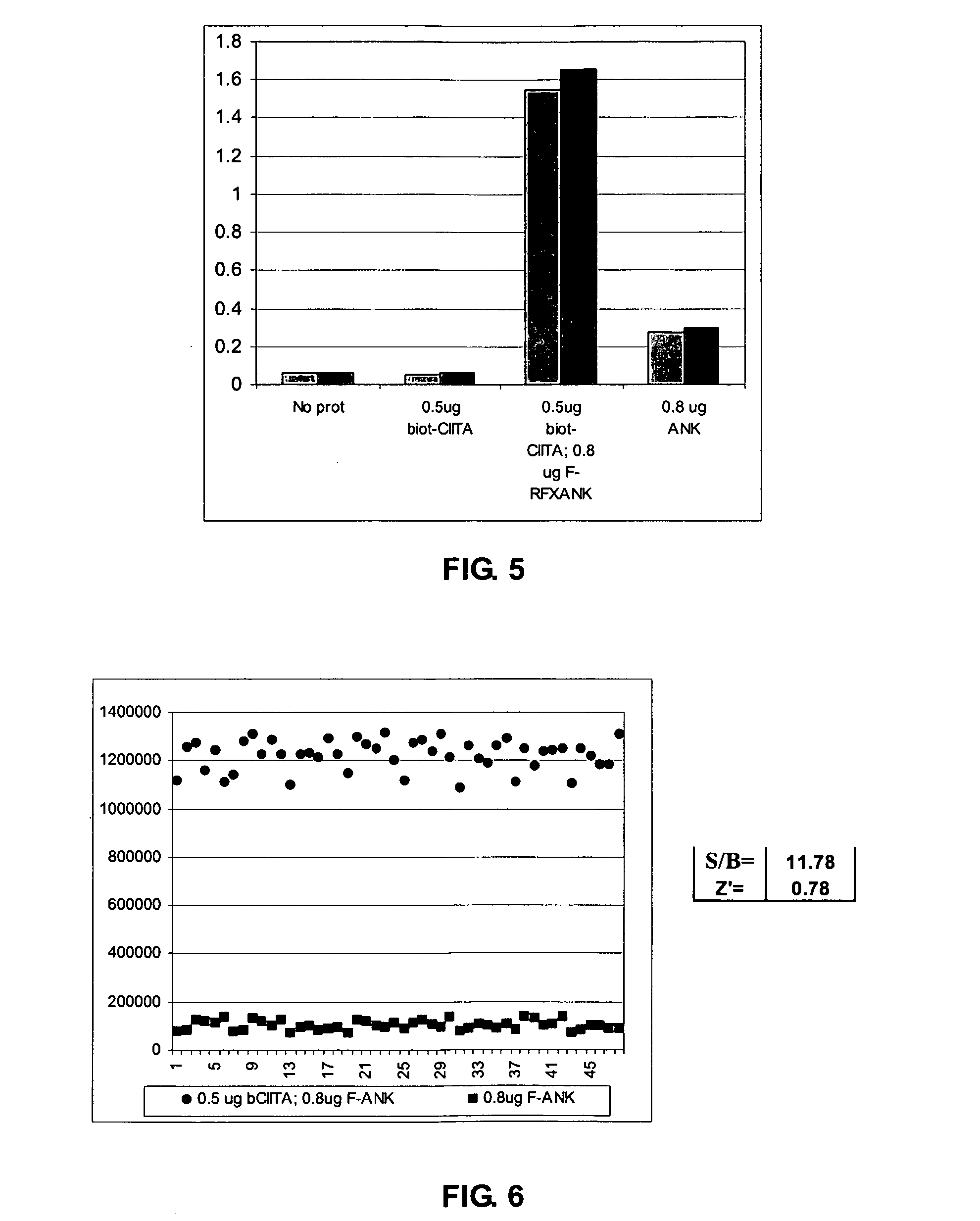Assays for the identification of modulators of MHC class II expression
a technology of mhc class ii and expression, applied in the field of compound identification, can solve the problems of time-consuming methods, inability to identify inhibitors of these interactions, and large limitation of screening assay approaches, and achieve the effect of enhancing mhc ii gene expression
- Summary
- Abstract
- Description
- Claims
- Application Information
AI Technical Summary
Benefits of technology
Problems solved by technology
Method used
Image
Examples
example 1
[0088] Reporter gene assay: A phenotype-based, high through-put screen (HTS)-compatible cell-based assay for the identification of inhibitors of MHC class II expression was developed. A reporter gene (Renilla luciferase) controlled by an MHC class II promoter (HLA-DRA), and a control reporter (firefly luciferase) driven by an IFN-γ-inducible gene promoter other than an MHC class II promoter (FIG. 1) are co-transfected into cells that express these two genes after IFN-γ induction (e.g., Me67.8 human melanoma cell line). It is recognized that IFN-γ induces MHC class II promoters. A test compound is added into the cell culture, e.g., concomitantly, prior to or subsequent to IFN-γ induction. After a time lag of one to several hours (e.g., 16 hours) a standard Dual Luciferase Reporter assay (DLR) is performed. Compounds that inhibit the induction of the Renilla luciferase, but not the firefly luciferase, are identified and characterized as selective MHC class II inhibit...
example 2
Assay for CIITA-RFXANK Interaction
[0089] Assays have been developed to directly determine interactions between CIITA and RFXANK. A graphic depiction of the assay is provided in FIG. 4. This assay is suitable for determination of interactions between CIITA and any member of the RFX complex, such as RFX5 and RFXAP.
[0090] Plasmids. The CIITA gene sequence was cloned into a modified pBAC-2 cp vector (Novagen) with a biotinylation tag inserted at the 5′ end of the gene. The RFXANK gene sequence containing a Flag tag at its N-terminus was cloned into a pFBHT vector (Invitrogen). These plasmids were used to generate recombinant baculoviruses according to standard procedures. Protein production: Sf9 cells grown in SF-900II medium (Invitrogen) were infected at MOI of 10 for 72 h before harvesting. To obtain in vivo biotinylated CIITA, Sf9 cells were co-infected with an E. coli biotin ligase expressing baculovirus (BirA gene) at a MOI of 1. Protein were purified using metal chelating affin...
example 3
Assay for RFX Complex / DR-Promoter Interaction
[0094] Assays have been developed to directly determine interactions between the RFX complex and an MHC class II promoter. A graphic depiction of an exemplary assay is provided in FIG. 8.
[0095] Plasmids. The RFXANK gene sequence containing a Flag tag at its N-terminus and the RFXAP gene sequence containing an HA tag at its N-terminus were cloned into the pFastBac Dual vector (Invitrogen) that allows for the co expression of two gene in insect cells. The RFX5 coding sequence was cloned into the pFBHT vector (Invitrogen). These plasmids were used to generate recombinant baculoviruses according to standard procedures. Protein production: Sf9 cells grown in SF-900II medium (Invitrogen) were co infected at MOI of 5 for each virus for 48 h before harvesting. Cells were lysed in lysis buffer (50 mM Tris-Cl pH8.5; 5 mM β-Me; 200 mM KCl; 1% NP-40) supplemented with Complete (EDTA-free) protease inhibitor cocktail (Roche). The lysed extracts wer...
PUM
| Property | Measurement | Unit |
|---|---|---|
| time lag | aaaaa | aaaaa |
| bioluminescent protein | aaaaa | aaaaa |
| bioluminescent | aaaaa | aaaaa |
Abstract
Description
Claims
Application Information
 Login to View More
Login to View More - R&D
- Intellectual Property
- Life Sciences
- Materials
- Tech Scout
- Unparalleled Data Quality
- Higher Quality Content
- 60% Fewer Hallucinations
Browse by: Latest US Patents, China's latest patents, Technical Efficacy Thesaurus, Application Domain, Technology Topic, Popular Technical Reports.
© 2025 PatSnap. All rights reserved.Legal|Privacy policy|Modern Slavery Act Transparency Statement|Sitemap|About US| Contact US: help@patsnap.com



